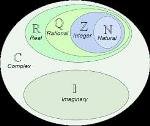Set theory notation is about describing how we should represent sets when we are discussing them or solving problems involving sets. It is about communication in set language.

We use these braces { } to enclose the elements of a set. for example
{7, 11, 13} is the set containing 7, 11, and 13.
- : means “such that“. for example {x : x > 2} is the set of all x such that x is greater than 2.
- ∈ means “is element of“ for example 11 ∈ {7, 11, 13} asserts that 11 is an element of the set {7, 11, 13}.
- ∉ means “is not an element of“ for example 4 ∉ {7, 11, 13} because 4 is not an element of the set {7, 11, 13}.
- ⊆ means ” is a subset of“ for example A ⊆ B asserts that A is a subset of B, that is; every element of A is also an element of B.
- ⊂ means “is a proper subset of“. for example A ⊂ B asserts that A is a proper subset of B: every element of A is also an element of B, but A , B.
∩ means “Intersection of“ for example A ∩ B is the intersection of A and B: the set containing all elements which are elements of both A and B.
- ∪ means “union of“. for example A ∪ B is the union of A and B: is the set containing all elements which are elements of A or B or both.
- × means “Cartesian product of“ for example A × B is the Cartesian product of A and B: the set of all ordered pairs (a, b) with a ∈ A and b ∈ B.
- \ means “set difference between”. for example A \ B is set difference between A and B; that is, the set containing all elements of A which are not elements of B.
- A’ or Ac means “complement of set A”.
- The complement of A (AC)is the set of everything which is not an element of A.
- |A| means “cardinality or size of A“.
- The cardinality (or size) of A is the number of elements in A sometimes written as n(A).
Sets Relationships
Two sets are be equal if they have exactly the same elements. For example {7, 11, 13} = {11, 7, 13} as every element in first set is the same element in the second set.
The order in which the elements are written down in does not matter.
{7, 11, 13} = {7, 8 + 3, 6 + 2 + 5} = {VI, XI, XIII} = {7, 11, 13, 7 + 6}
The above statement shows that the way elements are represented in a set does not matter, as long as the elements evaluates to the same value at the end.
Consider the sets A = {7, 11, 13} and B = {7, 11, 13, 20}.
A and B are not equal but every element of A is also an element of B.
we say that A is a subset of B, or in symbols A ⊂ B or A ⊆ B.
Both symbols are read “is a subset of.”
This is analogous to the difference between < and ≤.
⊆ is analogous to ≤ and ⊂ comparable to <.
Set theory notation: power set
power set of a subset A is the set made from all possible subsets of A.
power set of A is often written as P(A) or sometimes as 2A .
consider the set A = {5, 7, 9}.
P(A) ={ ∅, {5}, {7}, {9}, {5, 7}, {5, 9}, {7, 9}, {5, 7, 9}}.
If the set A has n elements, then the power set has 2n elements.
Please note that all elements of power set P(A) are sets and NOT number elements. Therefore; 5 ∉ P(A) but {5} ∈ P(A) since elements of P(A) are not numbers but sets.
NOTE:
{5} ⊄ P(A) because not everything in {5} is in P(A).
However, {{5}} ⊆ P(A).
The only element of {{5}} is the set {5} which is also an element of P(A).
cardinality of a set
cardinality of a set is the number of distinct elements a set has often referred as the size of the set. if a set A = {a, b, c, d, e, f}, then it’s cardinality is 6 as it has 6 distinct element. that is |A|=6.
For a set with a finite number of elements, the cardinality of the set is simply the number of elements in the set.
The cardinality of the set B = {1, 2, 3, 4, 1, 2, 3} is 4 as it has 4 distinct elements. repeated elements are not counted when determining cardinality of a set.


Leave a Reply